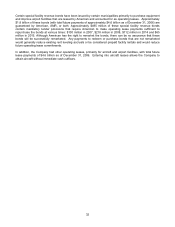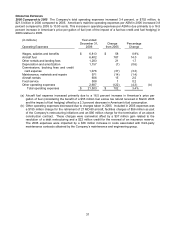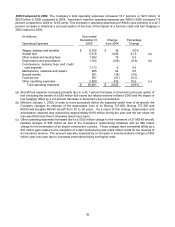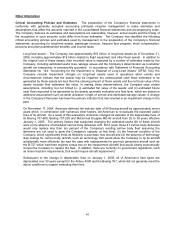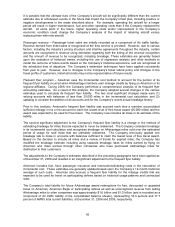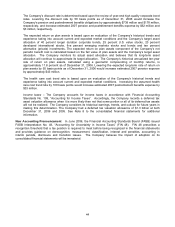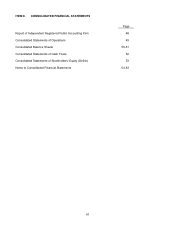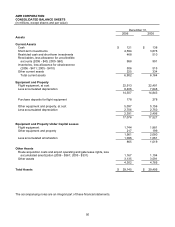American Airlines 2006 Annual Report Download - page 46
Download and view the complete annual report
Please find page 46 of the 2006 American Airlines annual report below. You can navigate through the pages in the report by either clicking on the pages listed below, or by using the keyword search tool below to find specific information within the annual report.42
It is possible that the ultimate lives of the Company’s aircraft will be significantly different than the current
estimate due to unforeseen events in the future that impact the Company’s fleet plan, including positive or
negative developments in the areas described above. For example, operating the aircraft for a longer
period will result in higher maintenance, fuel and other operating costs than if the Company replaced the
aircraft. At some point in the future, higher operating costs and/or improvement in the Company’s
economic condition could change the Company’s analysis of the impact of retaining aircraft versus
replacing them with new aircraft.
Passenger revenue – Passenger ticket sales are initially recorded as a component of Air traffic liability.
Revenue derived from ticket sales is recognized at the time service is provided. However, due to various
factors, including the industry’s pricing structure and interline agreements throughout the industry, certain
amounts are recognized in revenue using estimates regarding both the timing of the revenue recognition
and the amount of revenue to be recognized, including breakage. These estimates are generally based
upon the evaluation of historical trends, including the use of regression analysis and other methods to
model the outcome of future events based on the Company’s historical experience, and are recognized at
the scheduled time of departure. The Company’s estimation techniques have been applied consistently
from year to year. However, due to changes in the Company’s ticket refund policy and changes in the
travel profile of customers, historical trends may not be representative of future results.
Frequent flyer program – American uses the incremental cost method to account for the portion of its
frequent flyer liability incurred when AAdvantage members earn mileage credits by flying on American or its
regional affiliates. During 2006, the Company performed a comprehensive analysis of its frequent flyer
accounting estimates. As a result of this analysis, the Company adopted several changes in the various
estimates used to calculate its frequent flyer liability. The two most significant changes made were (1)
valuing accounts with balances of less than 25,000 miles in the incremental cost calculation, and (2)
updating to consider the addition of all accounts and for the Company’s recent actual breakage history.
Prior to this analysis, American's frequent flyer liability was accrued each time a member accumulated
sufficient mileage in his or her account to claim the lowest level of free travel award (25,000 miles) and the
award was expected to be used for free travel. The Company now includes all miles in its estimate of the
liability.
The second significant adjustment to the Company’s frequent flyer liability is a change in the method of
estimating breakage for miles that are expected to never be redeemed. The Company considers breakage
in its incremental cost calculation and recognizes breakage on AAdvantage miles sold over the estimated
period of usage for sold miles that are ultimately redeemed. The Company previously applied one
breakage rate to miles in accounts with balances sufficient to claim the lowest level of free travel award.
Based on the decision to include all miles and a review of trends for expired miles, the Company has
modified the breakage estimate including using separate breakage rates for miles earned by flying on
American and miles earned through other companies who have purchased AAdvantage miles for
distribution to their customers.
The adjustments to the Company’s estimates described in the preceding paragraphs have been applied as
of December 31, 2006 and resulted in an insignificant adjustment to the frequent flyer liability.
American includes fuel, food, passenger insurance and reservations/ticketing costs in the calculation of
incremental cost. These estimates are generally updated based upon the Company’s 12-month historical
average of such costs. American also accrues a frequent flyer liability for the mileage credits that are
expected to be used for travel on participating airlines based on historical usage patterns and contractual
rates.
The Company’s total liability for future AAdvantage award redemptions for free, discounted or upgraded
travel on American, American Eagle or participating airlines as well as unrecognized revenue from selling
AAdvantage miles to other companies was approximately $1.6 billion and $1.5 billion (and is recorded as a
component of Air traffic liability in the consolidated balance sheets), representing 18.3 percent and 17.7
percent of AMR's total current liabilities, at December 31, 2006 and 2005, respectively.


